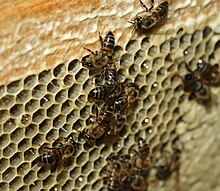Cape honey bee
| Cape honey bee | |
|---|---|
 |
|
| Cape Honeybees gorging on honey. | |
| Scientific classification | |
| Kingdom: | Animalia |
| Phylum: | Arthropoda |
| Class: | Insecta |
| Order: | Hymenoptera |
| Family: | Apidae |
| Genus: | Apis |
| Species: | A. mellifera |
| Subspecies: | A. m. capensis |
| Trinomial name | |
|
Apis mellifera capensis Eschscholtz, 1822 |
|
The Cape honey bee or Cape bee (Apis mellifera capensis) is a southern South African subspecies of the Western honey bee. They play a major role in South African agriculture and the economy of the Western Cape by pollinating crops and producing honey in the Western Cape region of South Africa.
The Cape honey bee is unique among honey bee subspecies because workers can lay diploid, female eggs, by means of thelytoky, while workers of other subspecies (and, in fact, unmated females of virtually all other eusocial insects) can only lay haploid, male eggs. Not all workers are capable of thelytoky - only those expressing the thelytoky phenotype, which is controlled by a recessive allele at a single locus (workers must be homozygous at this locus to be able to reproduce by thelytoky).
In 1990 beekeepers transported Cape honey bees into northern South Africa, where they don't occur naturally. This has created a problem for the region's A. m. scutellata populations. Reproducing diploid females without fertilization bypasses the eusocial insect hierarchy; an individual more related to her own offspring than to the offspring of the queen will trade in her inclusive fitness benefits for individual fitness benefits of reproducing her own young.
This opens up the possibility of social parasitism: if a female worker expressing the thelytokous phenotype from a Cape honey bee colony can enter a colony of A. m. scutellata, she can potentially take over that African bee colony. A behavioral consequence of the thelytoky phenotype is queen pheromonal mimicry, which means the parasitic workers can sneak their eggs in to be raised with those from the African bees, and their eggs aren't policed by the African bee workers because they're similar to the African bee queen's eggs. As a result the parasitic A. m. capensis workers increase in number within a host colony, while numbers of the A. m. scutellata workers that perform foraging duties (A. m. capensis workers are greatly under-represented in the foraging force of an infected colony) dwindle, owing to competition in egg laying between A. m. capensis workers and the queen, and to the eventual death of the queen. This causes the death of the colony upon which the capensis females depended, so they will then seek out a new host colony.
...
Wikipedia
